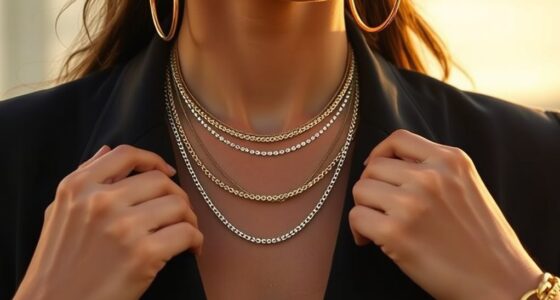The history of the little black dress begins in the early 20th century, with Coco Chanel revolutionizing fashion by emphasizing simplicity, comfort, and elegance. It gained popularity during the flapper era, Hollywood’s Golden Age, and post-war modernization, symbolizing sophistication and versatility. Over time, it evolved through the 1960s and into contemporary designs, reflecting cultural shifts and sustainable trends. If you keep exploring, you’ll discover how this timeless piece continues to symbolize confidence and adaptability today.
Key Takeaways
- The Little Black Dress (LBD) originated in the early 20th century, emphasizing simplicity and practicality inspired by Coco Chanel’s minimalist designs.
- It gained popularity during the 1920s Flapper Era, symbolizing freedom, modernity, and self-expression for women.
- Hollywood stars of the Golden Age, like Audrey Hepburn, cemented the LBD’s status as a symbol of elegance and glamour.
- Post-war modernization introduced sustainable fabrics and eco-conscious designs, evolving the dress into a symbol of modern awareness.
- Today, the LBD remains a versatile, timeless staple, continuously adapted with innovative fabrics and fashion trends.
Origins and Early Influences
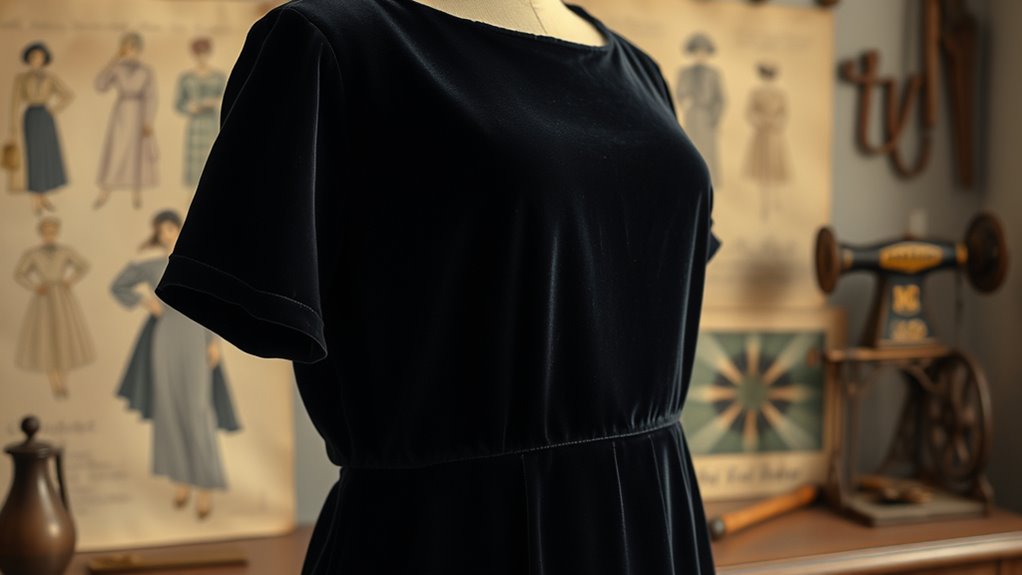
The origins of the little black dress trace back to the early 20th century when fashion shifted toward simplicity and practicality. During this time, vintage glamour was still evident but became more accessible through streamlined designs. The textile evolution played a key role, as lighter, more versatile fabrics like silk and jersey emerged, making elegant yet comfortable dresses possible. Designers like Coco Chanel revolutionized fashion by stripping away unnecessary ornamentation, creating a chic, timeless silhouette. Her vision made black a symbol of sophistication and versatility, suitable for both day and evening wear. As a result, the little black dress became a staple, embodying both modernity and elegance. This era marked the foundation for its enduring status in fashion history. Additionally, the development of fashion innovation techniques contributed to the creation of adaptable and universally flattering styles.
The Rise of the Flapper Era
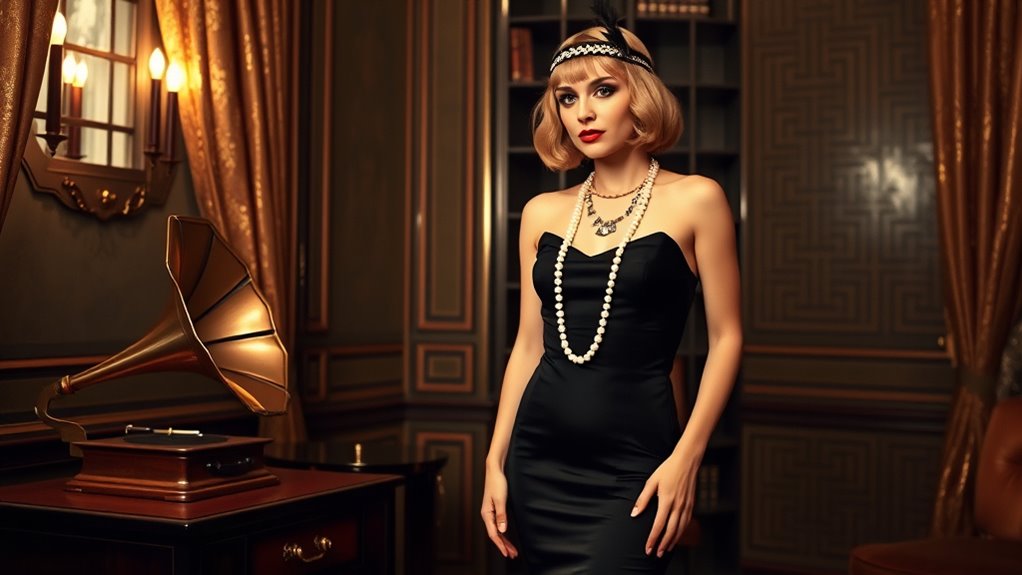
Have you ever wondered how the flapper movement transformed the fashion landscape in the 1920s? During the Jazz Age, flapper fashion revolutionized style by emphasizing freedom, individuality, and modernity. Women started shedding restrictive clothing, opting for shorter hemlines, dropped waistlines, and more relaxed fits. You’d see fringed dresses, beaded accessories, and bold makeup that challenged traditional norms. The flapper era encouraged you to express yourself boldly, blending music, dance, and style into a new cultural identity. This movement made the Little Black Dress even more significant, as it became a versatile staple that suited the daring spirit of the time. The Jazz Age’s energetic vibe and flapper fashion reshaped women’s fashion forever, emphasizing confidence, independence, and a break from the past. Additionally, the era’s emphasis on personal expression helped pave the way for more diverse and inclusive fashion choices.
Coco Chanel’s Revolutionary Design
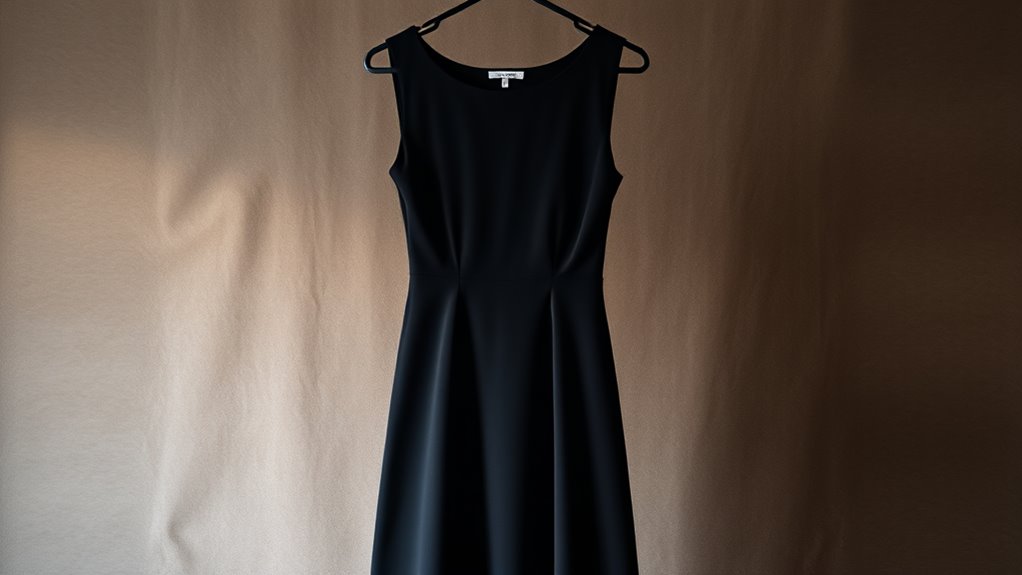
Coco Chanel changed fashion forever by breaking the rules and redefining elegance. Her designs challenged traditional norms, making simplicity and comfort stylish. This shift set the stage for the iconic evolution of the Little Black Dress. Today, the floating on water concept influences modern beachwear, emphasizing comfort, functionality, and effortless style.
Challenging Fashion Norms
Although fashion in the early 20th century remained rigid and formal, Coco Chanel dared to defy these conventions by introducing designs that prioritized comfort and simplicity. She challenged norms by:
- Embracing sustainable fabrics, making fashion more eco-conscious.
- Creating gender-neutral fashion, blurring traditional male-female distinctions.
- Simplifying silhouettes to favor ease and movement.
- Reducing ornamentation, shifting focus from extravagance to function.
Her revolutionary ideas encouraged women to break free from constrictive clothing, promoting practicality. Chanel’s focus on comfort and sustainability reshaped fashion’s future, inspiring designers to rethink traditional standards. By challenging these norms, she paved the way for modern, inclusive, and environmentally conscious styles. Her influence continues to inspire today’s push toward more diverse and functional fashion choices.
Design innovation played a crucial role in shaping her approach to redefining fashion standards.
Iconic Style Evolution
Building on her challenge to fashion norms, Coco Chanel revolutionized style with designs that emphasized elegance, comfort, and simplicity. She introduced vintage patterns that broke away from ornate, restrictive styles, making fashion more accessible. Chanel’s fabric innovations played a crucial role—she popularized jersey fabric, once considered only for sportswear, creating a sleek, flexible look perfect for the little black dress. Her approach streamlined the silhouette, removing unnecessary embellishments and focusing on clean lines. This evolution in style allowed women to move freely and feel confident, transforming the dress into a versatile wardrobe staple. Additionally, her emphasis on color accuracy in fabric choices helped ensure that her designs maintained their visual appeal across different lighting conditions. Chanel’s revolutionary design paved the way for timeless elegance, inspiring countless fashion trends and solidifying her place as a pioneer in modern fashion.
Hollywood’s Golden Age and the Dress’s Stardom
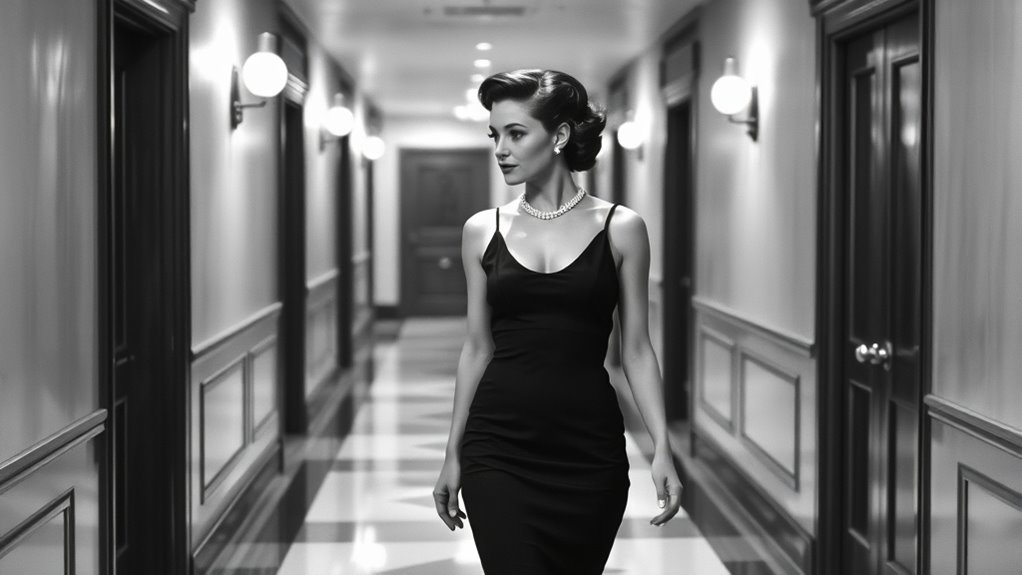
During Hollywood’s Golden Age, the little black dress became a symbol of elegance and sophistication on the silver screen. Glamorous celebrities, like Audrey Hepburn and Marilyn Monroe, popularized it as the go-to outfit for style and charm. Your attention is drawn to how vintage advertisements showcased these stars in sleek black dresses, elevating their allure. Consider how:
- Stars worn the dress in iconic films, amplifying their mystique.
- Designers crafted timeless silhouettes that Hollywood embraced.
- Public fascination grew as magazines highlighted these glamorous moments.
- The dress became synonymous with effortless sophistication and versatility.
These elements made the little black dress a staple of Hollywood glamour, cementing its place as an enduring symbol of style and star power.
Post-War Transformations and Modernization
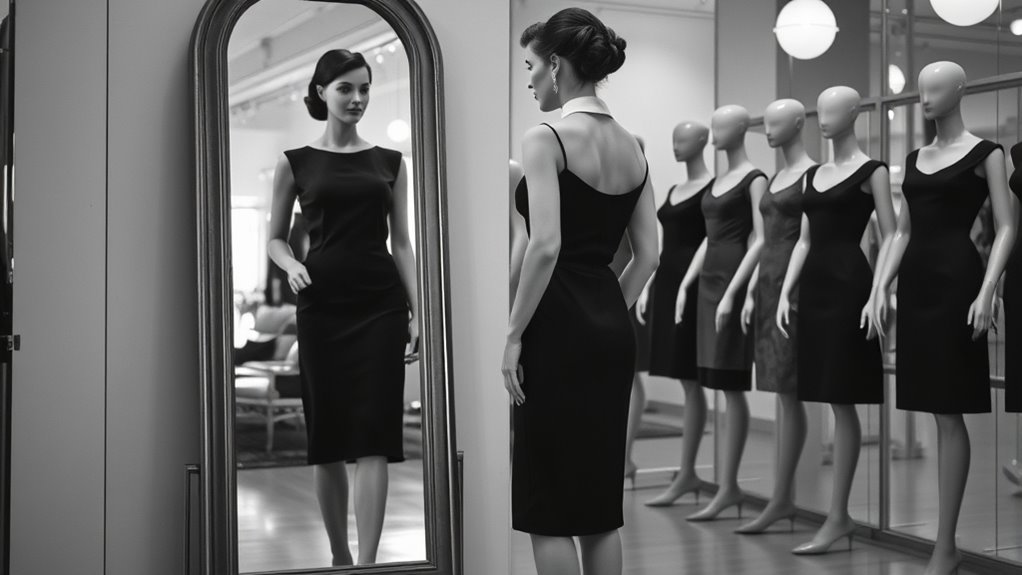
After Hollywood’s Golden Age elevated the little black dress to iconic status, the post-war era brought fresh perspectives and a desire for change. You see, designers began exploring sustainable fabrics, making the dress more environmentally friendly without sacrificing style. This shift reflected a growing awareness of fashion’s impact on the planet. At the same time, fashion philanthropy gained momentum, as brands and designers used their influence to support charitable causes and promote ethical practices. You might notice how modern little black dresses now often feature eco-friendly materials and are linked to social initiatives, emphasizing that fashion can be both stylish and responsible. Additionally, unique and wicked planters reflect a similar trend of combining creativity with sustainability, inspiring fashion to embrace eco-consciousness. These transformations helped the dress evolve from a simple staple into a symbol of modern consciousness and sustainable fashion.
The 1960s and the Birth of the Iconic Style

The 1960s transformed fashion with the Mod movement, bringing bold, innovative styles to the forefront. Coco Chanel’s timeless influence continued to shape the little black dress, making it a symbol of elegance and rebellion. During this era, swinging styles and youthful energy redefined how women wore their iconic black dresses. Additionally, the decade’s emphasis on special events and themed breakfasts reflected the era’s spirit of creativity and social engagement.
Mod Fashion Revolution
The 1960s sparked a fashion revolution that transformed the Little Black Dress into a symbol of modernity and freedom. You notice how mod fashion brings bold changes, emphasizing youth and individuality. During this time, you see four key trends shaping the scene:
- Vintage revival: Reworking classic styles into fresh, edgy looks.
- Designer collaborations: Fashion houses teaming up to create statement pieces.
- Bright colors and geometric patterns that challenge tradition.
- Mini skirts and sleek silhouettes that redefine femininity.
This era’s influence pushes the LBD to new heights, making it adaptable and versatile. You’ll also find that designers embraced the era’s experimental spirit, collaborating across genres and styles, elevating the Little Black Dress into an icon of rebellion and chic sophistication. Incorporating bold color palettes and innovative textiles helped redefine the dress as a statement of individuality and artistic expression.
Coco Chanel’s Influence
Coco Chanel’s influence in the 1960s reshaped the way women approached fashion, solidifying her role as a pioneer of modern style. She championed feminine empowerment by designing clothing that emphasized comfort and confidence, breaking away from restrictive, ornate fashions. Her emphasis on minimalist elegance encouraged women to embrace simplicity without sacrificing style. Through her designs, you learn that elegance doesn’t require excess; it’s about clean lines and effortless grace. Chanel’s ideas empowered women to feel more liberated and self-assured in their appearance. Her timeless approach shifted fashion toward practicality and sophistication, making the little black dress a symbol of understated confidence. In the 1960s, her legacy continued to influence how women expressed themselves through fashion, balancing femininity with strength. Additionally, her innovative use of timeless design principles helped to establish the enduring appeal of the little black dress as a versatile wardrobe staple.
Swinging Sixties Style
As the 1960s unfolded, fashion experienced a revolutionary shift, fueled by youthful energy and a desire to break free from traditional styles. You notice how vintage glamour blends with textile innovation, creating bold new looks. During this era:
- You embrace mini dresses that redefine silhouette and freedom.
- Bright colors and geometric patterns dominate runway and street style.
- Innovative fabrics like PVC and mod textiles revolutionize garment construction.
- Accessories become statement pieces, adding flair to simple black dresses.
- The use of high-pressure techniques in textile manufacturing contributed to the development of new fabric textures and finishes, influencing fashion’s evolution during this dynamic period.
This period transforms the little black dress into a versatile icon, blending sophistication with rebellious spirit. The era’s focus on innovation and daring style makes fashion more accessible and expressive than ever before. You’re witnessing the birth of a timeless style, shaped by the energy of the swinging sixties.
The Little Black Dress in Contemporary Fashion
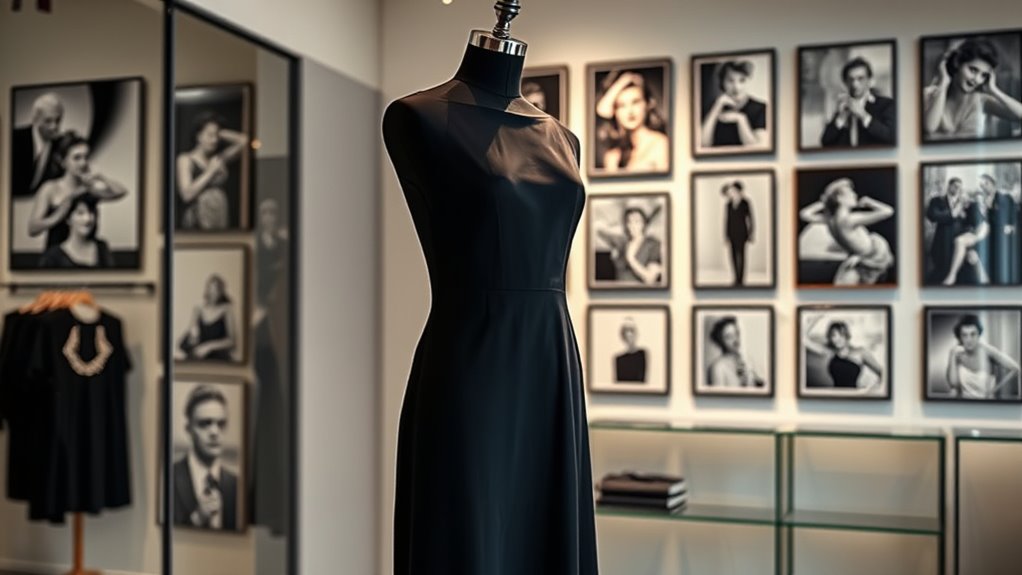
Today, the Little Black Dress remains a versatile staple that continues to evolve with fashion trends, offering endless styling possibilities for any occasion. In contemporary fashion, designers prioritize sustainable fabrics, making your LBD eco-friendly without sacrificing style. You might choose dresses crafted from organic cotton, recycled polyester, or innovative sustainable textiles. Digital fashion also plays a role, allowing you to preview designs virtually or customize your dress online. This technology helps reduce waste and supports more sustainable production methods. The modern LBD adapts to your lifestyle, whether it’s a sleek, minimalist look or a bold statement piece. Its timeless appeal, combined with sustainable practices and digital innovation, keeps the Little Black Dress relevant and exciting in today’s fashion landscape.
Cultural Significance and Symbolism
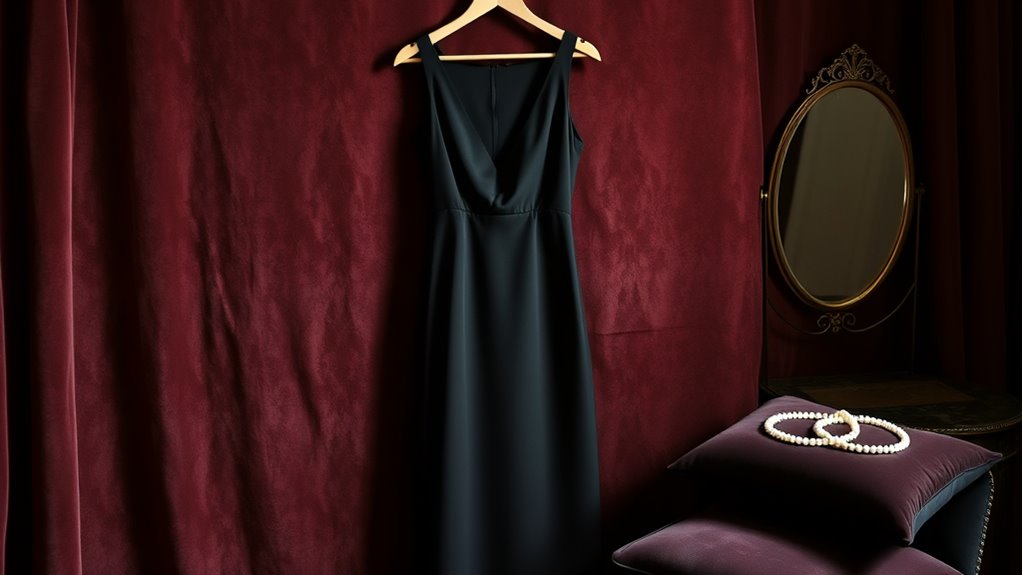
The Little Black Dress has long held a powerful place in cultural symbolism, representing more than just fashion. Its symbolic meaning varies across contexts, embodying elegance, sophistication, and resilience. You see this in how it’s used to signal different social messages:
- As a symbol of timeless style, it conveys confidence and simplicity.
- In moments of mourning, it reflects mourning and respect.
- During celebrations, it stands for empowerment and independence.
- Its versatility makes it a cultural icon of adaptability and reinvention. This cultural symbolism extends beyond clothing, shaping perceptions of femininity and strength. The little black dress’s symbolic meaning evolves, yet it consistently maintains its role as a powerful emblem in society. Through history, it’s become a universal language of elegance and resilience.
Enduring Legacy and Future Trends
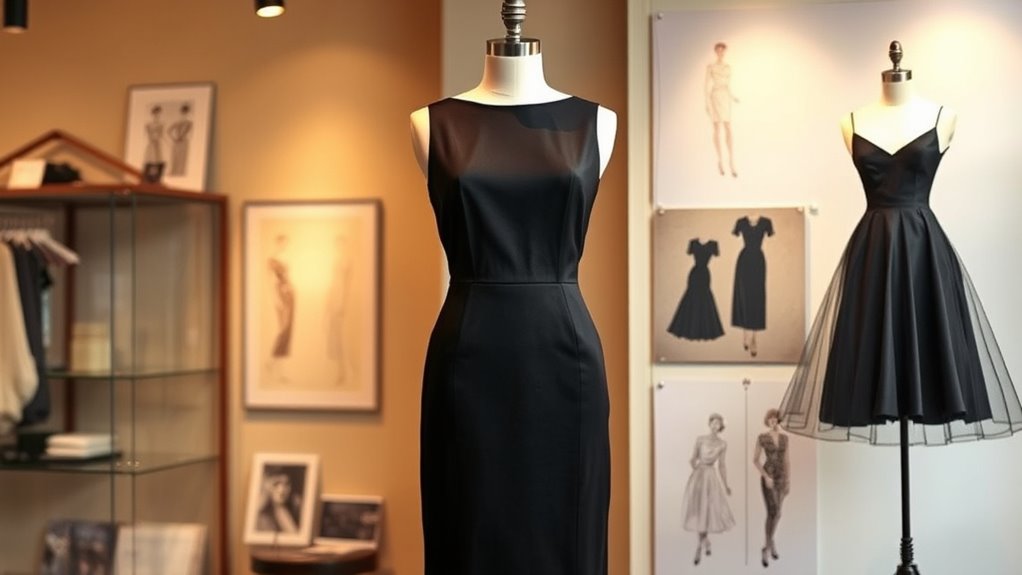
The enduring legacy of the Little Black Dress lies in its ability to adapt and remain relevant across changing fashion landscapes. Today, designers embrace sustainable practices, using eco-friendly fabrics and ethical production to guarantee the dress’s future relevance. Technological innovations also play a vital role, from 3D printing to virtual fitting rooms, making the dress more accessible and customizable. These advancements help reduce waste and improve fit, aligning fashion with environmental consciousness. As trends evolve, you can expect the Little Black Dress to continue balancing timeless elegance with modern innovation. Its versatility and adaptability ensure it remains a staple, inspiring new generations to reinterpret its classic silhouette through sustainable and technological lenses. The dress’s future is as enduring as its history.
Frequently Asked Questions
How Did the Little Black Dress Influence Women’s Social Empowerment?
You see, the little black dress revolutionized women’s social empowerment by becoming a symbol of elegance and independence. It changed the fashion industry by offering a versatile, accessible option that challenged traditional gender roles. As more women embraced this simple yet stylish garment, societal change followed, encouraging women to express themselves confidently and take control of their image. The dress helped break barriers, inspiring women to assert their individuality and power.
What Materials Were Historically Used in the Earliest Versions of the LBD?
You might find that the earliest versions of the Little Black Dress used simple, yet durable fabrics like wool, silk, and crepe de chine, reflecting the historical craftsmanship of the time. These materials were chosen for their elegance and practicality, allowing women to wear them for various occasions. The craftsmanship focused on clean lines and minimal embellishments, making the dress versatile and timeless, which contributed to its lasting appeal.
How Did Global Fashion Trends Impact the Evolution of the Little Black Dress?
You see, global fashion trends have greatly influenced the evolution of the little black dress. The fashion industry’s shifting styles and innovations push designers to adapt, making the LBD versatile and timeless. Color symbolism also plays a role, as black represents sophistication and rebellion at different times. As trends change, so does the dress’s design, ensuring it remains a staple that reflects the era’s cultural attitudes and fashion movements.
Are There Specific Cultural Variations of the Black Dress Worldwide?
Imagine attending a formal event in Japan where a simple black dress carries cultural symbolism, reflecting elegance and respect. Different cultures have unique variations of the black dress, blending traditional attire with modern fashion. For example, in India, black may symbolize sophistication, but traditional garments like the sari or kurta often influence black dress styles. These variations showcase how cultural symbolism shapes black dress choices worldwide.
What Are Some Iconic Lesser-Known Designers Associated With the LBD?
You’ll find lesser-known designers making waves with their innovative LBDs, blending avant-garde designs and sustainable fabrics. These creatives push boundaries beyond classic styles, offering unique, eco-friendly options. By exploring their work, you discover fresh perspectives on the iconic dress, emphasizing sustainability and innovation. Their avant-garde innovations and eco-conscious fabrics challenge traditional notions, making the LBD not just timeless but also a symbol of forward-thinking fashion that resonates with modern values.
Conclusion
The little black dress is more than just fabric; it’s a timeless canvas that whispers stories of rebellion, elegance, and resilience. Like a chameleon, it adapts through eras, always ready to transform with your mood and moment. Its enduring legacy is a proof to fashion’s power to speak without words. As you wear it, remember—you hold the brush to paint your own chapter in this legendary tapestry of style.


